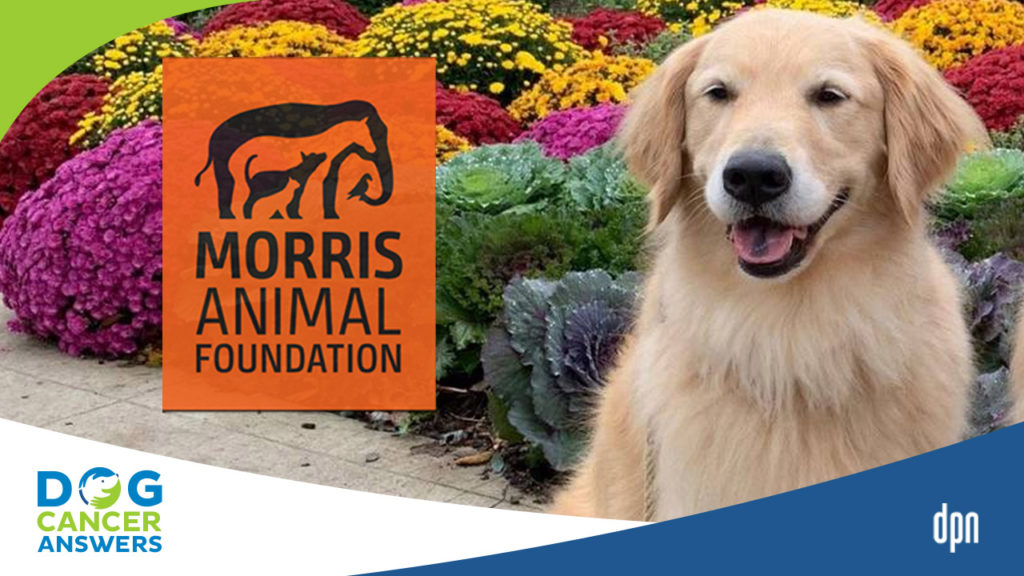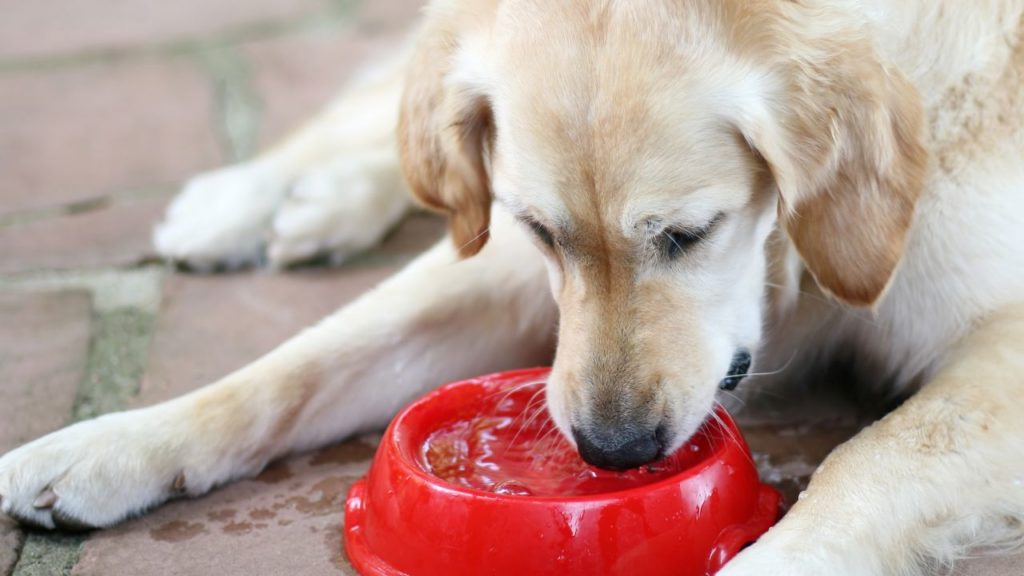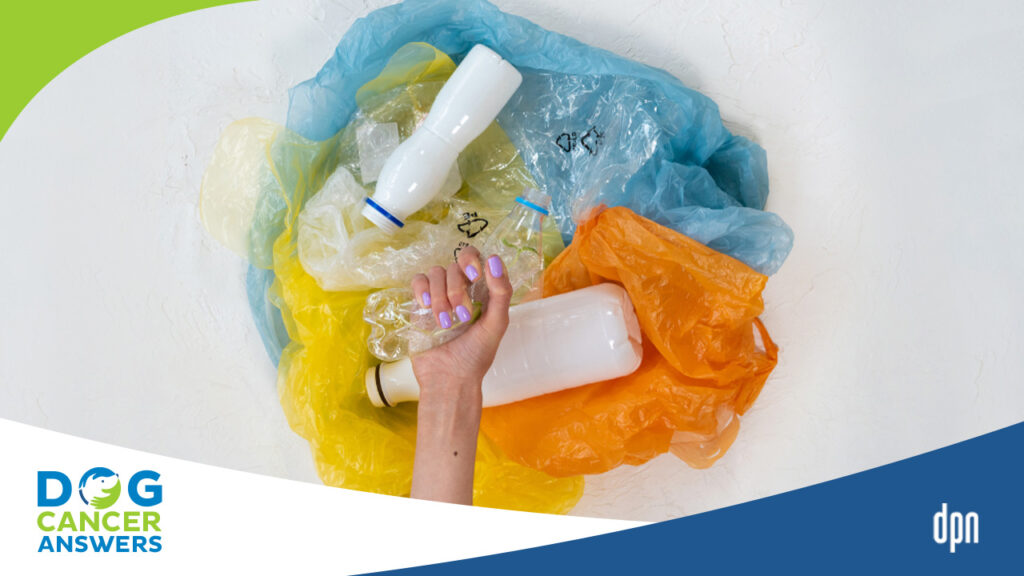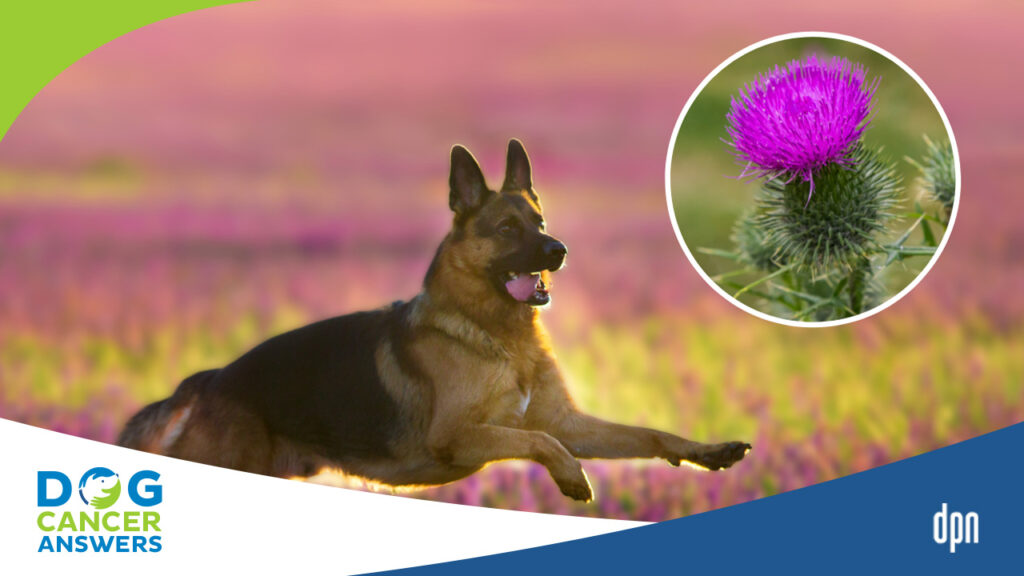EPISODE 176 | RELEASED July 18, 2022
Pollution and Cancer in Dogs | Dr. Lauren Trepanier
When it comes to lymphoma and bladder cancer, environmental pollution plays a role in causing dog cancer.
SHOW NOTES
Double board-certified veterinarian Dr. Lauren Trepanier has lost three Boxers to lymphoma, and she’s not letting that slide. She is currently studying the impact of carcinogens caused by environmental pollution on lymphoma in Boxers and transitional cell carcinoma in all dogs.
For lymphoma, the initial study found that Boxers have a higher risk of developing lymphoma if they live within 10 miles of a nuclear power plant, or within two miles of a chemical supplier or active crematorium. Current studies are directly measuring the volatile organic compounds (VOCs) and herbicides in the urine of Boxers with lymphoma as well as their levels in the air and tap water in those dogs’ homes. Dr. Trepanier’s lab is also teaming up with the Morris Animal Foundation Golden Retriever Lifetime Study to measure VOCs and herbicides in the urine of Goldens with lymphoma.
For bladder cancer, the initial study found that dogs were at a higher risk of developing bladder cancer if they lived in a county with higher ozone concentrations or higher levels of trihalomethanes in the tap water. They also found that dogs and their owners share similar urinary levels to two carcinogens, with 5-7% of apparently healthy people and dogs having levels high enough to damage their DNA and potentially cause cancer. Current studies are measuring the urinary and household levels of acrolein and arsenic.
Listen in to learn more about these studies, and scroll down to view the recruitment fliers.
Links Mentioned in Today’s Show:
Golden Retriever Lifetime Study
[00:00:00] >> Dr. Lauren Trepanier: We did find that between 5% and 7% of people and dogs had levels of these chemicals in their urine that were damaging to urinary cells, so cause DNA damage to urinary cells. And these were just a spot check in a healthy person.
[00:00:17] >> Announcer: Welcome to Dog Cancer Answers, where we help you help your dog with cancer.
[00:00:23] >> Molly Jacobson: Hello friend. Today on Dog Cancer Answers, I’ve got a great guest for you. She’s Dr. Lauren Trepanier. She’s incredibly talented and an extraordinarily dedicated cancer researcher who’s working with dogs to find out what in our environment is causing cancer in dogs. There are some links between environmental pollution and human cancer, and she is setting out to make sure that we all understand that those same environmental pollutants can also contribute to cancer in our dogs.
So she’s joining us here today from the University of Wisconsin. Dr. Lauren Trepanier thank you so much for joining us today.
[00:01:04] >> Dr. Lauren Trepanier: It’s great to be here.
[00:01:06] >> Molly Jacobson: I’m really interested in this study that has just come out about the environmental toxins that we know cause certain cancers in humans or are related to certain cancers in humans. But now you have done the hard leg work of making sure that yes, it’s also true for dogs, it seems.
[00:01:26] >> Dr. Lauren Trepanier: Yeah. So one of the studies that we just finished was looking at two populations of dogs: dogs with bladder cancer, which is very similar to bladder cancer in people, and dogs with lymphoma, which is very similar to non-Hodgkin’s lymphoma people.
And for the lymphoma study, we just focused on Boxers ’cause there’s a strong breed risk for lymphoma in Boxers. And for lymphoma study, we found that if you looked at the counties in which dogs with lymphoma lived compared to the counties of dogs that were the same age, breed, and sex, but didn’t have lymphoma, that those dogs lived in areas with higher ozone.
So we think of ozone as a good thing up in the, the stratosphere, ’cause it protects us from UV radiation. But ozone close to the surface of the earth where we live is a sign that there’s pollution. And ozone is a breakdown product of chemicals called VOCs, that are pollutants in the environment. So if you have high ozone, that’s a marker for high VOC air pollution.
So things like benzene and other chemicals that we’re familiar with. Things that are found in industrial pollution, but also in diesel exhaust and car exhaust.
[00:02:38] >> Molly Jacobson: So ozone is in the air.
[00:02:39] >> Dr. Lauren Trepanier: Yes.
[00:02:40] >> Molly Jacobson: But it can be broken down by chemicals that are used in processing plants or in everyday materials that could break down and release it. And the ozone’s now next to our heads, rather than way up in the sky, protecting us from the sun.
[00:02:56] >> Dr. Lauren Trepanier: Right.
And it has some human health problems too. So if there’s high ozone in the air, people tend to have more asthma and things. It’s not clear whether it’s the ozone itself or it’s just a marker of high air pollution.
So we, we saw that dogs were more likely to live in these counties that had high VOC concentrations. And we’re now looking at where these dogs live and whether it’s close to areas of oil and gas drilling or particularly fracking-
[00:03:23] >> Molly Jacobson: Oh.
[00:03:23] >> Dr. Lauren Trepanier: -which is unconventional oil and gas drilling, where you set a horizontal drill, agitate the earth with chemicals, and then suck up natural gas that is released by that fracking. And we are able to map all the oil and gas drills and fracking sites in the country through a website called Enverus, and we can match that exactly with where those dogs live. And so we’re working on that in both Boxers with lymphoma and Golden Retrievers with lymphoma.
[00:03:56] >> Molly Jacobson: So this is an ongoing study.
[00:03:58] >> Dr. Lauren Trepanier: Yes.
Moving forward, we are looking at Boxers and Golden Retrievers with lymphoma, not just where they live, but we’re actually measuring chemicals in their urine. So we’re measuring metabolites of two VOCs. So one’s a metabolite of benzene, so air pollutant, and one’s a metabolite of trichloroethylene, another pollutant, and these are found in the air and they’ve both been associated with lymphoma in people, you know, under working conditions in factories.
And so we chose them because there’s a strong link with lymphoma in people. We wanna see if lower concentrations in air pollution, you know, not in an occupational setting, might be a trigger for lymphoma in dogs. So we’re looking at Boxers with lymphoma and Golden Retrievers with lymphoma as well as matched controls.
[00:04:45] >> Molly Jacobson: Matched controls, meaning there are dogs who are identical in, in all of the important ways, but do not have lymphoma.
[00:04:52] >> Dr. Lauren Trepanier: Right. Age, breed, sex, but no lymphoma. So they they’ve lived the same age as that similar dog and have not gotten lymphoma. Doesn’t mean they will never get it, but they don’t have it now. And we’re measuring the metabolites of benzene and trichloroethylene in their urine. We’re also measuring those chemicals in the air in the home.
For the Boxer study, we send the owner this canister and they open the valve, put it on their kitchen counter for eight hours, close the valve, send it back to us so we can measure airborne chemicals in the home. And we’re also measuring herbicides.
So we’re measuring herbicides in the urine and herbicides in tap water, ’cause you can see herbicides as runoff from, you know, agricultural waste. And we’re focusing on Roundup, which is glyphosate 2,4-D, and these are two chemicals that have been strongly associated with lymphoma in people. And so we wanna see if there’s the same association in dogs, whether it’s a Golden Retriever or a Boxer.
[00:05:50] >> Molly Jacobson: So are the chemical levels that you’re looking at that are specifically in the home, have they done those sorts of studies for humans where they’re looking at home chemicals or do they only focus on the workplace?
[00:06:02] >> Dr. Lauren Trepanier: In the United States, it’s mostly been workplace exposure, so people will wear badges or they’ll measure, you know, benzene that’s stuck to hemoglobin or other chemicals in your blood, you know, they can measure it in your bloodstream. There are some studies from China and other industrialized countries looking at, say, benzene exposures in children, in schools that are in industrial versus rural areas.
And there’s, you know, there’s differences in benzene concentrations in those kids. But there hasn’t been a lot of work looking at it in the home environment. And so on another level, we’re interested in this because multicentric lymphoma in dogs is very similar to non-Hodgkin’s lymphoma in people. And there are certainly plenty of people that get non-Hodgkin’s lymphoma that don’t have, you know, industrial jobs or other risk factors.
And so it would help us identify non-occupational, non-smoking risk factors for lymphoma potentially in people as well.
[00:06:58] >> Molly Jacobson: Right. So this could be – it’s for the dogs, but it’s also possibly for people. That there may be things that are present in our homes and are being broken down and we’re just unaware.
[00:07:09] >> Dr. Lauren Trepanier: Right.
[00:07:09] >> Molly Jacobson: That they are causing real problems later on.
[00:07:13] >> Dr. Lauren Trepanier: Right. And we’re also looking at bladder cancer as a second cancer. And again, we chose that because it’s a, clearly an environmental cancer in people. So about half of it is caused by smoking and about a third with, you know, occupational industrial exposures.
But about a third remains unexplained in people. Bladder cancer in dogs is very similar to the most aggressive form of bladder cancer in people. And they both have a bad prognosis. So again, we’re taking dogs with bladder cancer and dogs that are made matched for age, breed, and sex who don’t have bladder cancer and we’re measuring a different group of chemicals to see household exposure to these chemicals are associated with bladder cancer.
And we’re focusing on arsenic, which can be found in tap water and some foods, but also in dust, you can measure it in the dust in your house. And acrolein which is an indoor air pollutant from frying foods, but also from industrial pollution.
[00:08:09] >> Molly Jacobson: Industrial pollution, like maybe it’s in carpets or?
[00:08:12] >> Dr. Lauren Trepanier: It’s in cigarette smoke. It’s in industrial pollution.
[00:08:16] >> Molly Jacobson: Okay.
So like if you had, I don’t know, I don’t wanna name a brand, but like a little oil to loosen up your lock and you spilled it on the floor, you might, there might be something there.
[00:08:26] >> Dr. Lauren Trepanier: That’s not acrolein, but the, those would be like volatile organic compounds that would sort, sort of those household chemicals.
[00:08:33] >> Molly Jacobson: Okay.
[00:08:33] >> Dr. Lauren Trepanier: And so we’re measuring these acrolein, arsenic, and then some herbicides in these dogs with bladder cancer and controls. And for this study, we’re also measuring the levels of those chemicals in the owners of these dogs.
[00:08:47] >> Molly Jacobson: Oh.
[00:08:48] >> Dr. Lauren Trepanier: Oh, we did a preliminary study in healthy dogs and healthy, their healthy owners, and we found that high levels of acrolein metabolites in a dog was a signal for high levels of acrolein metabolites in their owner, which tells us that it’s coming from a shared source. And we saw the same thing for arsenic. So that tells us it’s probably not, you know, in the food, ’cause these dogs were typically eating commercial kibble and the owners obviously weren’t.
[00:09:15] >> Molly Jacobson: Most owners don’t, yeah.
[00:09:17] >> Dr. Lauren Trepanier: Yeah. We think there’s some shared environmental exposures related to acrolein and arsenic. And we’re looking at the levels that we measure and then exposing human and dog urinary cells to those levels of chemicals to see whether they’re high enough to cause DNA damage. And we did find that between 5% and 7% of people and dogs had levels of these chemicals in their urine that were damaging to urinary cells, so cause DNA damage to urinary cells. And these are just, it’s just a spot check in a healthy person.
[00:09:50] >> Molly Jacobson: In a healthy person. So they’re not symptomatic in any way.
[00:09:53] >> Dr. Lauren Trepanier: No.
[00:09:53] >> Molly Jacobson: But they have this cellular level DNA damage from these specific compounds that are in their home and their dogs do too.
[00:10:03] >> Dr. Lauren Trepanier: And so in this study, we think that a household that has a dog with bladder cancer may be a sentinel or a canary in the coal mine for a household that has higher than typical levels of one or more chemicals that could lead to bladder cancer. That doesn’t mean that if your dog has bladder cancer, you’re gonna get bladder cancer, but it may mean that your household has higher than typical chemical exposures that you could address with various remediation methods.
[00:10:30] >> Molly Jacobson: Wow. This feels like, that this study is really foundational to possibly us really starting to understand some things about cancer risk that if – one of the questions I get all the time in our support group for people whose dogs have cancer is how did this even happen?
[00:10:47] >> Dr. Lauren Trepanier: Yeah. Yeah.
[00:10:48] >> Molly Jacobson: Why is my dog have cancer?
[00:10:50] >> Dr. Lauren Trepanier: Yeah.
[00:10:50] >> Molly Jacobson: And why do so many people in my life have cancer, because cancer rates have escalated in humans as well and it feels like this is very, like, you’re looking at the home and it feels very tender actually to me.
[00:11:03] >> Dr. Lauren Trepanier: Yeah.
[00:11:03] >> Molly Jacobson: Like, oh, there’s things in my home that could possibly harm. Scary.
[00:11:07] >> Dr. Lauren Trepanier: Right. I mean, I’m a veterinary internist, so like we, we diagnose a lot of cancer from a dog that’s medically sick, you know?
[00:11:15] >> Molly Jacobson: Right.
[00:11:15] >> Dr. Lauren Trepanier: And then we refer them to an oncologist. So we’re the people that they’re asking, what did I do? What could I have done differently? Did this cause it? Did that cause it? And so we wanna be able to give people some evidence based answers. You know, you can’t, it’s hard to make an iron-clad association between a chemical and a cancer, particularly when you’re – we’re not giving these dogs cancer with the chemicals, we’re measuring in pet dogs.
But if there’s an association, then we can, we can give people recommendations. So for example, it’s easy not to use herbicides in your yard, unless you’re in a neighborhood where it’s required, but you could advocate for that not to be required. You know, you could walk your dog on lawns that are not pristine.
I don’t let my dogs walk on weedless lawns ’cause I know they’ve been treated with herbicides. And for like volatile organic compounds, there’s some really cool indoor air filtration units that can clear benzene from the air. So if you’re armed with the knowledge that say a benzene exposure, herbicide exposure is a risk factor for lymphoma or bladder cancer, and particularly if you have a high risk breed, that helps you take a little bit more control over what your dog is exposed to.
[00:12:26] >> Molly Jacobson: And if we find these things out now, our dogs in the future and our human selves can also benefit from that.
[00:12:33] >> Dr. Lauren Trepanier: Right.
[00:12:33] >> Molly Jacobson: That they have a lower risk generally, because we have removed some of those things that could elevate their risk over time.
[00:12:40] >> Dr. Lauren Trepanier: That’s the hope. And you know, also if these chemicals are damaging DNA or altering DNA gene expression, which the chemicals can do that too. And that’s ongoing even after the cancer is diagnosed. You know, that may make it harder for the dog’s cancer to be cured if it’s constantly, you know, making new mutations and things.
So it also could, potentially, benefit dogs that have already been diagnosed with cancer, if there’s strong associations with particular exposures.
[00:13:09] >> Molly Jacobson: This is making me think about how we started doing this podcast because we are associated with a book called The Dog Cancer Survival Guide that Dr. Dressler, and I think he authored it in 2007, we published it in 2008. And there’s a lot of information about environmental pollutions and one of the huge pushback we got at the beginning, especially, less lately, but certainly a couple decades ago, was don’t worry about things that you can’t control. Like why are you even telling people about the problems in the water, the problems in the soil, the problems in the food supply.
Like, why are you talking about these things? And this is why, because we can do something about it. And we might not be able to do something right today, but it changes the way that we live and it’s better health for everybody.
[00:14:00] >> Dr. Lauren Trepanier: Right. Right.
[00:14:01] >> Molly Jacobson: You mentioned that you’re an internist. I understand that you have a couple of board certifications. Talk a little bit about your background, your credentials, what brought you here.
[00:14:11] >> Dr. Lauren Trepanier: So I went to vet school at Cornell, ’cause I grew up in upstate New York, and then I did residency training in internal medicine. So that’s a board certification, you know, basically any disease in the abdomen plus respiratory disease we specialize in. Because we use so many medicines and we studied the way disease develops and responds, I got interested in pharmacology, or drugs, and so I ended up doing a PhD in pharmacology and getting boarded in, in veterinary clinical pharmacology as part of that. Which means I, I didn’t get a real job till I was 40.
[00:14:48] >> Molly Jacobson: You like to learn things.
[00:14:49] >> Dr. Lauren Trepanier: Yeah. Yeah.
[00:14:49] >> Molly Jacobson: That’s your job.
[00:14:51] >> Dr. Lauren Trepanier: I mean, every step I took, I was enjoying and making enough money to live on, so, it was fine.
[00:14:56] >> Molly Jacobson: Yeah. But what a gift, you know, we need people like you who wanna learn things. Thank you.
[00:15:04] >> Dr. Lauren Trepanier: Well, it is, it is a luxury because you know, when you’re in specialty practice, you’re seeing cases all day and you don’t really have any time to do research, you know? And so in an academic environment, we have time dedicated to do research and we’re, we’re expected to do it. And we have, you know, the opportunity to have graduate students and things. So to me, it’s a real luxury to be able to sit and think about these things, read papers, make connections, and come up with ideas to test.
[00:15:30] >> Molly Jacobson: Well, that’s a great place to just take a quick break and then we’ll be back after the break with Dr. Lauren Trepanier.
So let’s go back to our conversation with Dr. Lauren Trepanier. We were just talking during the break about One Health, which is this sort of new way of looking at health, not just for humans as separate, but as all of us as animals who share an environment and often have similar issues going on. So why don’t you talk a little bit about this, this initiative that’s going on and how you’re involved in it and what it’s looking like for the future?
[00:16:05] >> Dr. Lauren Trepanier: Well, the advantage of looking at, say a dog with a cancer that is the same as what people get is dogs have a compressed lifespan, so they get the cancers at an earlier timeframe and they tend to have just a more accelerated course of disease. And so if you’re looking for an environmental trigger, it’s gonna be closer to the timeframe in which they got the cancer than a person, where it might be decades later.
[00:16:30] >> Molly Jacobson: We’ll remember it.
[00:16:31] >> Dr. Lauren Trepanier: Right.
[00:16:31] >> Molly Jacobson: We’ll be like, oh, five years ago. I remember five years ago with my dog.
[00:16:35] >> Dr. Lauren Trepanier: It, yeah, it’s hard to remember, you know, 20 years back.
[00:16:38] >> Molly Jacobson: Right.
[00:16:38] >> Dr. Lauren Trepanier: And so I’m part of a, a CTSA One Health Alliance, which is a group of veterinary schools that are affiliated with these very large CTSA grants from NIH. It’s a Clinical and Translational Science Award.
[00:16:53] >> Molly Jacobson: Okay.
[00:16:53] >> Dr. Lauren Trepanier: And the goal of these bigger grants is to take scientific discoveries and translate them to human health. And veterinarians and pharmacists and biomedical engineers and nurses and dentists are all part of that consortium.
And so Deb Kochevar, who was a, a veterinarian and the former dean of the School of Veterinary Medicine at Tufts had the brilliant idea of bringing together all the vet schools that are under this CTSA umbrella and leveraging the resources associated with those grants to advance both human and animal health.
So this is another manifestation of One Health. And so I’m in charge of bringing veterinarians into research teams that are interdisciplinary between PhD scientists, MDs, and veterinarians, as well as other health professionals. And so one of the things we do is we have these summits that bring together, say, a bunch of people who are working on inherited heart disease.
And we look at it in cats and dogs and people and monkeys, and try to make connections and try to figure out what we can learn from each other. Because mouse models are very elegant because you can really break down specific causes. But these mice usually don’t have normal immune systems and they don’t live in the same environments as we do. And they’re not being exposed to the same levels of chemicals that we are.
But right next to us on the couch is a little canary who is exposed to those chemicals at the same level as we are, who does have a functional immune system, and gets the same cancers that we do. So the spontaneous diseases that occur in animals, particularly environmental cancers, I think are really, really important, not to replace mouse models, but to provide another piece of the puzzle.
[00:18:40] >> Molly Jacobson: Absolutely.
And I’m imagining that at these summits, as all of these different medical professionals from different specialties and looking at all of these different species at their hearts and going, I just imagine there’s a lot of, oh.
[00:18:55] >> Dr. Lauren Trepanier: Oh exactly. It was the, wow, I didn’t know that. And it’s usually the physicians that are going, I didn’t know that dogs got cardiomyopathy. I didn’t know they had, get atrial fibrillation. I mean, the veterinarians tend to be more dialed in because we read the human medical literature and do a lot of extrapolations to our patients, but the opposite isn’t necessarily true, you know?
[00:19:14] >> Molly Jacobson: Yeah.
[00:19:15] >> Dr. Lauren Trepanier: But so it’s, it’s cool to see the physician kind of go what, you know, I don’t have to like induce this disease, I can go out and recruit pets that have this disease. And so it’s, it gives them another tool to answer questions.
[00:19:28] >> Molly Jacobson: That’s wonderful. It’s wonderful. So did this study, these two studies that you’re currently working on, did those come out of this One Health consortium or were they something you were working on independently already?
[00:19:40] >> Dr. Lauren Trepanier: It’s something I was, I’m working on independently. The One Health initiatives are more arranging research fellowships and meetings and trainings to get veterinarians involved in research, with the model of the veterinarian studying a disease to advance veterinary medicine but also advance human health. And so that’s what my lab has been doing.
Our two current grants are funded by the AKC Canine Health Foundation.
[00:20:03] >> Molly Jacobson: Yeah.
[00:20:04] >> Dr. Lauren Trepanier: Then we just got a large grant from UW to look at the Golden Retriever Lifetime Study cohort. I don’t know if your listeners are familiar with this, but it’s a Morris Animal Foundation, the largest longitudinal study of dog health in the world when it was started. And it’s focused on Golden Retrievers because they have high incidence of cancers like lymphoma and hemangiosarcoma.
And the strength of the study is that the owners enroll their dogs when they’re less than two years of age and come in for blood samples, urine samples, other samples every year. And so we’re able to take Goldens that developed lymphoma and Goldens at the same age that did not and we’re gonna be measuring these environmental chemicals in their urine like I described, but we’re also able to look at the year prior to diagnosis.
We can look at chemical concentrations in their urine, and we can also look at potential markers of the chemicals causing DNA damage in their blood before they develop lymphoma, which could be potentially an early screening test or a way to tighten a connection between the chemical and the cancer if you can show that there’s an association with early DNA damage.
[00:21:16] >> Molly Jacobson: Wow. So I have like three different questions. I’m trying to figure out which one to ask first. First, I think I’ll ask, so the Goldens that are currently enrolled in the Morris Animal Foundation study – which we’ve had them on several times and we’ll put links in the show notes to all of that, and also the AKC, I just spoke with the head at AKC Canine Health Foundation, so we’ll put links to that in the show notes as well. So you’re gonna be able to recruit from the Golden study at Morris for your Golden lymphoma study.
[00:21:47] >> Dr. Lauren Trepanier: Right.
[00:21:47] >> Molly Jacobson: And then be able to talk to, those two programs will talk to each other about that dog and be able to say, oh, here’s what’s going on in the environment in their home, and here’s what their health status has been and all of that blood work and all of the scans and everything else that they’re doing over for Morris.
[00:22:05] >> Dr. Lauren Trepanier: Right.
[00:22:06] >> Molly Jacobson: You’ll have a complete picture really of not just their health, but their environment’s health.
[00:22:13] >> Dr. Lauren Trepanier: Yeah. And the, the beauty of this is that these dogs are recruited from all over the country. So it’s not like they’re just at, you know, veterinary oncologists, right? So there’s, there’s no selection bias for people who can afford to go in to an oncologist or afford to have diagnostic tests.
[00:22:28] >> Molly Jacobson: Right.
[00:22:28] >> Dr. Lauren Trepanier: These are people that started when their dogs were young and healthy.
[00:22:32] >> Molly Jacobson: Yeah. Got a Golden Retriever and said, yeah, I wanna contribute to science. And I’m willing to bring my dog in regularly to the vet to do all the vet things.
[00:22:40] >> Dr. Lauren Trepanier: I mean, there’s still a bias, you know, that it’s white, upper middle class owners that tend to participate in these studies.
[00:22:45] >> Molly Jacobson: Right.
[00:22:46] >> Dr. Lauren Trepanier: Always have to remember that we’re only looking at the slice of the pie and there has to be better ways for us to reach out to owners of dogs that develop cancer where they maybe can’t afford to confirm the diagnosis and things like that.
[00:23:00] >> Molly Jacobson: Yeah.
I think that that is a really important point. And what excites me about One Health and about the more I study about your study is that absolutely it’s happening in people who are privileged in many ways. And that’s why it’s so important that whatever information is found out is then implemented in all communities.
[00:23:21] >> Dr. Lauren Trepanier: Yes. Yes. We have a parallel study of our bladder cancer study, we have a parallel study in human patients, which we’re waiting on funding for. So I’m collaborating with a human urologist and we’re asking the question, are these volatile organic compounds and these herbicides associated with bladder cancer in people that don’t have occupational exposure, and are these exposures higher in people of lower socioeconomic strata?
So there’s various measures you can look, education, income, and there’s various, you know, areas of counties that are categorized by actually social deprivation index. So whether it’s a lower socioeconomic area. Because we would hypothesize that these areas that are less privileged may have higher levels of the pollutants that we’re interested in as far as bladder cancer.
[00:24:11] >> Molly Jacobson: Yeah. I would certainly as-, make that assumption. That seems like a good working hypothesis.
[00:24:16] >> Dr. Lauren Trepanier: Yeah.
[00:24:17] >> Molly Jacobson: Yeah. Based on all of the things.
So our listeners, I know many of them are already participating in the Morris Survey. So if they wanted to enroll their Golden Retriever, if they wanted to enroll their Boxer, if they wanted to enroll their dog, how do they get involved in your studies?
[00:24:35] >> Dr. Lauren Trepanier: Well, I provided some flyers. I think that will be attached to the podcast.
[00:24:39] >> Molly Jacobson: Yep.
[00:24:40] >> Dr. Lauren Trepanier: They can also just contact me directly. So my email will be available, if you just put my last name in to the University of Wisconsin website, it takes you to my website.
[00:24:48] >> Molly Jacobson: Pops right up.
Okay. We’ll put a link.
[00:24:50] >> Dr. Lauren Trepanier: So if they have a, a Boxer with lymphoma or a dog of any breed with bladder cancer, they just email me, we have to do a specific consent form, and then if they send us their address, we send them a kit. They collect urine, they collect tap water, they collect household dust, send it back to us, everything’s prepaid, there’s a questionnaire. And then once they send that back, we send them the canister, they collect the air, they send it back.
And so it’s, it’s a little bit of work on the owner’s part, just because lives are busy, and, you know, I still have stuff on my desk that I should have filled out for a human health study a long time ago. But we find that the, these owners are very motivated either because their own dog has cancer or they have, their dog is a breed that’s at risk for cancer. So.
[00:25:38] >> Molly Jacobson: And because also I imagine that you’ll be sharing the findings that you have about their own home with them, so they’ll have some information about their own environment that they might be able to use in their own life.
[00:25:49] >> Dr. Lauren Trepanier: Yes, we will contact anyone that has concentrations of pollutant that are higher than EPA regulations. So that’s an automatic thing. When we report the data, it’ll be an aggregate. So it won’t be individual dogs or people identified.
[00:26:03] >> Molly Jacobson: Right.
[00:26:04] >> Dr. Lauren Trepanier: Because when we have them fill out a questionnaire, it’s, it’s got a code number, it’s anonymized so we’re not finding out personal information about them.
[00:26:11] >> Molly Jacobson: Of course. Right.
[00:26:12] >> Dr. Lauren Trepanier: But yeah, we do get back to people if there’s higher than EPA limits. We don’t report all the values because for the most part, we don’t know what they mean, right. If something’s above EPA limits, we will contact them. And then we have everyone’s email address so we will be sending results out to all the participants.
It’s been amazing how people have reached out to us right after their dog was diagnosed with cancer. You know, we’re not, it’s not a clinical trial. We’re not treating the dogs. It’s looking for what could have happened in the past. And I’m amazed how generous people are.
[00:26:44] >> Molly Jacobson: At Dog Podcast Network, we say dog lovers are a breed apart.
[00:26:47] >> Dr. Lauren Trepanier: They are. It’s making my hair stand on end ’cause they really-
[00:26:50] >> Molly Jacobson: Same. I have, I literally have goose pimples.
[00:26:53] >> Dr. Lauren Trepanier: It’s a lovely thing.
[00:26:54] >> Molly Jacobson: It is. They’re wonderful people. I think they listen carefully to their dogs and take their lessons well.
[00:27:00] >> Dr. Lauren Trepanier: Yeah.
[00:27:01] >> Molly Jacobson: As they should. And when their dog gets cancer, of course they’re terrified and so sad. And they wanna do everything they can to help this beloved family member, but they genuinely also think about all of the dogs.
[00:27:17] >> Dr. Lauren Trepanier: They do.
[00:27:18] >> Molly Jacobson: And think "I wanna help all of the dogs. And if I could spare anybody from going through this, I would." And so we just have the most generous listeners.
[00:27:26] >> Dr. Lauren Trepanier: Yeah.
[00:27:27] >> Molly Jacobson: So I know that if you’ve got a Boxer or any breed that has bladder cancer, or Golden, you’re gonna be filling out the forms and asking to participate because I know how generous our listeners are.
[00:27:39] >> Dr. Lauren Trepanier: Well we, we really appreciate it. And it’s heartbreaking for me to see the pain in people’s emails when they contact us, ’cause I have been there. I’ve had, three Boxers of my own have died of lymphoma. And so this is personal for me.
[00:27:52] >> Molly Jacobson: Oh.
Yeah.
So if we wonder where ideas for research come from-
[00:27:57] >> Dr. Lauren Trepanier: Yeah. It comes from the heart.
[00:27:59] >> Molly Jacobson: Yeah. It comes from the heart.
I think that’s probably true for most scientific research, is that it’s a personal human story behind it that instigated it.
[00:28:08] >> Dr. Lauren Trepanier: Yeah. That’s very true. I, I find that a lot of grad students that come to work with us have a family member that, you know, have had lymphoma or had bladder cancer. It’s very personal for them.
[00:28:17] >> Molly Jacobson: Yeah.
Well, Dr. Trepanier, thank you so much for joining us today. Really appreciate it.
[00:28:25] >> Dr. Lauren Trepanier: I loved it, Molly. Thank you so much.
[00:28:30] >> Molly Jacobson: Hi, Kate Basedow-
[00:28:32] >> Kate Basedow: Hi, Molly.
[00:28:33] >> Molly Jacobson: -Producer of Dog Cancer Answers. So glad you joined me to debrief about that wonderful conversation that I just had with Dr. Lauren Trepanier.
[00:28:42] >> Kate Basedow: Absolutely.
[00:28:43] >> Molly Jacobson: Wow.
[00:28:43] >> Kate Basedow: What a cool pair of studies, both the information that we’re getting from them already and the stuff that they’re looking at going forward.
[00:28:52] >> Molly Jacobson: I think the thing that captured my imagination the most was the, the bottle they’re going to send so that you can put it on your counter, uncap it, and it’ll capture the air in your home.
[00:29:02] >> Kate Basedow: Yeah. To be able to actually know what’s going on in the air, in your home, that both you and your dog are breathing. And then the water supply that you and your dog are drinking of. I mean, I feel like we’ve all heard of Flint, Michigan, and-
[00:29:18] >> Molly Jacobson: Of course.
[00:29:18] >> Kate Basedow: But there’s so many other water supplies that are compromised that we may not know about, ’cause it’s a lower level.
[00:29:26] >> Molly Jacobson: Because it’s a lower level. And the idea that healthy dogs and healthy people in the pre-study were already seeing DNA changes in the cells in their bladder. My vision is in the future, you have like a dip stick for your water and you stick it under your tap. ‘Cause if you can measure those things directly in your home, then you can make changes.
[00:29:50] >> Kate Basedow: Yeah.
[00:29:50] >> Molly Jacobson: And you can make remediation or you could make different choices. Like maybe I won’t put in, maybe I won’t use that kind of paint, or, I don’t know. There’s a million things, right, that you don’t even think about.
[00:30:01] >> Kate Basedow: Yeah.
[00:30:01] >> Molly Jacobson: But could be contributing.
[00:30:02] >> Kate Basedow: Mm-hmm. And so many things that maybe we just don’t know about yet, like asbestos. For so long, it was a great thing ’cause-
[00:30:10] >> Molly Jacobson: Right. Yep.
[00:30:12] >> Kate Basedow: Flame retardant, right? That’s what asbestos was used for, and then it turned out, oh, by the way, if you inhale it, you’re gonna get cancer.
[00:30:19] >> Molly Jacobson: Almost guaranteed. Yeah, exactly. There’s so many things that we can learn from studies like these and it’s, I was really moved by how moved she was by the generosity of dog lovers. So I-
[00:30:31] >> Kate Basedow: Yeah.
[00:30:31] >> Molly Jacobson: -I really hope that, um, I know that if – thankfully Kanga doesn’t have bladder cancer, she has other things, other kinds of cancer – but I would certainly be contributing to that study.
[00:30:40] >> Kate Basedow: Yeah.
[00:30:41] >> Molly Jacobson: As a non Boxer, non Golden.
[00:30:44] >> Kate Basedow: It is truly wonderful that even if we’re at the point where we either can’t treat our dog’s cancer or have run out of options, there are still things we can do to help the next dog.
[00:30:57] >> Molly Jacobson: Right. Our next dog.
[00:30:59] >> Kate Basedow: Mm-hmm.
[00:30:59] >> Molly Jacobson: But also our neighbor’s next dog.
[00:31:00] >> Kate Basedow: Yeah.
[00:31:00] >> Molly Jacobson: And, you know, life is a moving parade is something we often say in our house and, you know, time marches on. So you gotta, obviously, be in the present moment, but you also have to be thinking about the future and about how things will play out later. And I know that every dog I’ve ever owned has been fed better-
[00:31:21] >> Kate Basedow: Mm-hmm.
[00:31:22] >> Molly Jacobson: -gotten a higher quality of life, like each dog sort of teaches me more for the next dog.
[00:31:27] >> Kate Basedow: Yep. We learn with each one.
[00:31:28] >> Molly Jacobson: We really do.
[00:31:29] >> Kate Basedow: Just like with training dogs, learn a new technique or behavior to teach each one.
[00:31:34] >> Molly Jacobson: Yup. As Dr. Trepanier said, that’s institutional memory.
[00:31:38] >> Kate Basedow: Yes.
[00:31:38] >> Molly Jacobson: Right, like.
[00:31:40] >> Kate Basedow: Learning from each other.
[00:31:41] >> Molly Jacobson: Yeah.
[00:31:41] >> Kate Basedow: Now if only mine didn’t teach each other the bad things.
[00:31:45] >> Molly Jacobson: Right. Well, that’s part of their charm.
Was there anything else that Dr. Trepanier said that you really, that spoke to your mind and heart?
[00:31:55] >> Kate Basedow: I definitely am fascinated by all of the researchers nowadays that are looking at things both from the species specific angle and from the One Health perspective. ’cause if you’re gonna spend the dollars and the time on a research study, it might as well benefit as many animals, including humans, as we can to make that effort go as, stretch it as far as we can to benefit as many beings as we can.
[00:32:26] >> Molly Jacobson: A hundred percent. I think that we should go be flies on the wall at a One Health Summit sometime.
[00:32:35] >> Kate Basedow: Hmm. That would be fascinating.
[00:32:37] >> Molly Jacobson: It would be fascinating. As a health nerd and a dog health nerd, I would love to just be there in the room with all those big brains as they learn and explain and understand. I think that would be very exciting. Well, thanks Kate for, uh, helping me to think through-
[00:32:55] >> Kate Basedow: You’re welcome.
[00:32:57] >> Molly Jacobson: -the interview with Dr. Trepanier. And thank you listener for joining us today. As always, we’re so pleased that you’re here and also so sorry that you have to be here. But we hope that we’re helping you in your journey with your dog and your dogs to come as well. And all of the dogs of all of the people you love, because that’s what it’s ultimately all really about here at Dog Podcast Network.
You can find our dogcanceranswers.com website. There were a lot of links and resources in today’s show, so make sure you check the show notes. If you’re watching us on YouTube, you can use the little More button to open that up and get the links. And if you are online, you can go to dogcanceranswers.com for the show notes. Follow us on the socials and don’t forget to call our Listener Line, (808) 868-3200. If you have any kind of question at all about dog cancer, we would love to take your question and get a veterinarian to answer it for you.
I’m Molly Jacobson. And from all of us here at Dog Podcast Network, I wish you and your dog, a warm Aloha.
[00:34:07] >> Announcer: Thank you for listening to Dog Cancer Answers. If you’d like to connect, please visit our website at dogcanceranswers.com or call our Listener Line at (808) 868-3200. And here’s a friendly reminder that you probably already know: this podcast is provided for informational and educational purposes only. It’s not meant to take the place of the advice you receive from your dog’s veterinarian.
Only veterinarians who examine your dog can give you veterinary advice or diagnose your dog’s medical condition. Your reliance on the information you hear on this podcast is solely at your own risk. If your dog has a specific health problem, contact your veterinarian. Also, please keep in mind that veterinary information can change rapidly, therefore, some information may be out of date.
Dog Cancer Answers is a presentation of Maui Media, in association with Dog Podcast Network.
Hosted By
SUBSCRIBE ON YOUR FAVORITE PLATFORM
Topics
Editor's Picks
CATEGORY











